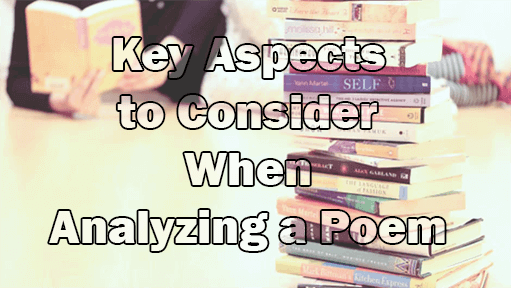Key Aspects to Consider When Analyzing a Poem:
Analyzing a poem involves exploring its various elements, understanding its structure, and interpreting its meaning. Here are key aspects to consider when analyzing a poem:
1. Read and Re-read:
- Begin your analysis by reading the poem carefully and multiple times. This helps you absorb the overall essence of the poem and allows you to notice subtle details on subsequent readings.
- During each reading, pay attention to the language, imagery, and emotions conveyed. Take note of words or phrases that stand out and seem significant.
- Consider the poem’s structure, and how it unfolds as you progress through it. Note any shifts in tone, mood, or theme.
2. Title:
- The title of a poem is often a key to its meaning. Analyze the title to gather initial insights into the theme or subject matter.
- Consider whether the title is straightforward or if it contains layers of meaning. Sometimes, titles can be metaphorical or symbolic, providing a lens through which to view the entire poem.
- Think about how the title might shape your expectations and influence your initial approach to the poem.
3. Speaker and Point of View:
- Identify who the speaker is in the poem. Is it the poet speaking in their own voice, or is it a persona or character they’ve created?
- Determine the point of view from which the poem is narrated. First-person narratives provide a personal perspective, while third-person perspectives may be more observational or detached.
- Consider how the choice of the speaker and point of view affects the reader’s understanding and emotional engagement with the poem.
4. Structure and Form:
- Examine the poem’s structure, which includes the arrangement of lines and stanzas. Note whether there’s a regular pattern or if it varies throughout the poem.
- Explore the rhyme scheme, if any. Traditional forms like sonnets or ballads often follow specific rhyme schemes, while free verse may lack a discernible pattern.
- Consider how the structure and form contribute to the overall impact of the poem. For example, a tightly structured poem may convey a sense of control, while free verse might evoke a more spontaneous or uncontrolled feeling.
5. Meter and Rhythm:
- Identify the meter, which is the pattern of stressed and unstressed syllables in a line. Common meters include iambic, trochaic, anapestic, and dactylic.
- Pay attention to the rhythm created by the meter. A regular rhythm can create a musical quality, while variations can convey tension, excitement, or a sense of unease.
- Consider how the meter and rhythm contribute to the overall flow and tone of the poem, and how they enhance the reader’s experience.
6. Rhyme and Sound Devices:
- Analyze the poem’s rhyme scheme, identifying patterns in how the lines rhyme with each other. Common rhyme schemes include AABB, ABAB, and ABCB.
- Look for sound devices such as alliteration (repetition of initial consonant sounds), assonance (repetition of vowel sounds), and consonance (repetition of consonant sounds). These devices contribute to the poem’s musicality and can emphasize certain words or create a specific mood.
7. Imagery:
- Explore the vivid and sensory language used in the poem to create mental images. Consider the visual, auditory, olfactory, gustatory, and tactile elements.
- Pay attention to metaphorical and symbolic imagery. Imagery serves to evoke emotions, deepen understanding, and make the poem more engaging for the reader.
- Evaluate how the use of imagery enhances the overall impact and meaning of the poem.
8. Symbolism and Metaphor:
- Identify symbols within the poem—objects, actions, or elements that represent deeper meanings. Symbols often carry cultural, historical, or universal significance.
- Look for metaphors, where one thing is compared to another to convey a hidden meaning. Metaphors can offer fresh perspectives and contribute to the poem’s richness.
- Consider how symbols and metaphors contribute to the thematic layers of the poem and convey the poet’s intended message.
9. Theme:
- Determine the central theme or themes of the poem. A theme is the underlying message, insight, or idea that the poet conveys about life, human nature, or a specific subject.
- Identify recurring motifs or ideas. Themes can be explicit or implicit, and understanding them is crucial to unraveling the poem’s deeper meaning.
- Reflect on how the theme resonates with the poem’s other elements, such as imagery, tone, and symbolism.
10. Tone and Mood:
- Analyze the tone, which is the poet’s attitude toward the subject or audience. It can be expressed through word choice and the overall atmosphere of the poem.
- Consider the mood, which is the emotional atmosphere created by the poem. The mood may shift throughout the poem, and understanding it adds depth to your interpretation.
- Reflect on how tone and mood contribute to the reader’s emotional response and overall experience with the poem.
11. Word Choice and Diction:
- Scrutinize the poet’s choice of words and language. Consider both the denotations (literal meanings) and connotations (emotional or cultural associations) of specific terms.
- Evaluate the formality or informality of the language used. Diction can impact the overall tone of the poem, influencing how readers perceive the speaker and the subject.
- Notice if there are any words with multiple meanings or if the poet uses language in a way that creates ambiguity or layers of meaning.
12. Context and Historical/Cultural Background:
- Explore the historical, cultural, or biographical context of the poem. Understanding the circumstances in which the poem was written can provide insights into the poet’s intentions.
- Consider the societal and cultural influences that may have shaped the poet’s perspective. Biographical details about the poet’s life, experiences, or beliefs can also contribute to your interpretation.
- Be aware of any specific historical events, literary movements, or cultural shifts that might be relevant to the poem.
13. Interpretation and Personal Response:
- Formulate your interpretation of the poem based on the cumulative analysis of its elements. Consider how the various poetic devices work together to convey meaning.
- Reflect on your personal response to the poem. Poetry often elicits emotional reactions, and your subjective interpretation is a valid aspect of the analysis.
- Be open to multiple interpretations and the possibility that others may have different perspectives on the poem. Discussing your interpretation with others can enhance your understanding.
14. Compare and Contrast:
- Compare the analyzed poem with other works by the same poet. Look for recurring themes, stylistic choices, or motifs that characterize the poet’s body of work.
- Contrast the poem with works from a similar genre or time period. Understanding how the poem fits into a larger literary context can deepen your appreciation for its uniqueness.
- Consider how the poem resonates with or challenges other poems you have encountered. This comparative analysis can offer additional layers of insight into the poem’s significance.
Remember that poetry analysis is subjective, and different readers may interpret a poem in various ways. Feel free to express your personal response and engage with the poem on an emotional level as well.

Assistant Teacher at Zinzira Pir Mohammad Pilot School and College










